
Constr_materials
.pdf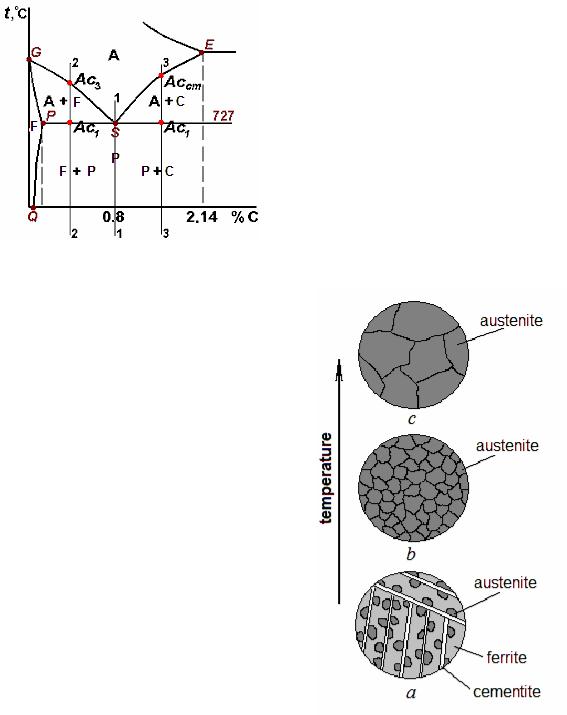
Figure 10.3 Critical points upon heating of steel
Heating from a room temperature up to the line PSK does not lead to any changes of structure; it remains pearlitic. When temperature Ac1 = 727 °С is reached, transformation of pearlite to austenite begins. Nucleation of a new phase, austenite, occurs in ferrite, on the boundaries between ferrite and cementite (Fig. 10.4, a). The crystal lattice of iron is reconstructed from body-centered cubic into face-centered cubic: Fe Fe . Stimulus of transformation is a difference in free energy of a new and old phase: at the raised temperatures
iron possesses a less storage of free energy and is an equilibrium phase. Transformation develops as diffusion process at the expense of joining new atoms of iron to a growing austenite crystal. Cementite is gradually dissolved in austenite grains.
For eutectoid steel Ac3 = Ac1 = 727 °С; it means that transformation begins and finishes at the same temperature. (Energy income while heating is spent for formation of a new surface.)
The further heating from Ac3 to solidus does not lead to phase transformations, but with temperature increase austenite grain grows (Fig. 10.4, b, c). This process results from the fact that in coarse-grained structure the surface of grain boundaries is less therefore surface energy is less, too. The coarse-grained structure is more
stable from thermodynamic point of view. Simultaneously at the expense of diffusion the carbon content in a solid solution is levelled (right after transformation former ferrite and cementite sites strongly differ in carbon concentration).
91
Created with novaPDF Printer (www.novaPDF.com). Please register to remove this message.
Upon heating of hypoeutectoid steels (Fig. 10.3, composition 2-2) the same transformations occur in pearlite colonies at the temperature Ac1 = 727 °С. Then, at increase in temperature to Ac3, surplus ferrite gradually transforms to austenite by origin and growth of grains of a new phase. The further heating is accompanied by levelling of carbon concentration at the expense of diffusion and growth of the austenite grain.
Upon heating of hypereutectoid steels (Fig. 10.3, composition 3-3) the difference is that in the temperature range from Ac1 to Accm a surplus cementite dissolves in austenite.
10.3. AUSTENITE GRAIN AND PROPERTIES OF STEEL
In each pearlite colony a lot of austenite grains nucleate and grow, thus leading to the refinement of steel grains upon heating. But it is important to remember that heating up to very high temperature will inevitably lead to the grain growth. It may cause two kinds of defects:
a)Overheat is a growth of austenite grain above a size, admissible under service conditions. The overheated steel has the reduced plasticity and impact strength. But this drawback can be corrected by repeated heating to normal temperatures.
b)Overburning means an oxidation and partial melting of grain boundaries at the temperatures close to solidus line. Occurrence of oxides at the austenite grain boundaries is incorrigible reject; such steel has conchoidal fracture and is very brittle. It is sent to remelting.
Grain growth upon heating occurs with different rate depending on the steel composition. In steels, deoxidized with silicon and manganese, very rapid growth of austenite grain is observed. They are coarse-grained steels. And steels, deoxidiezed with aluminum additionally, are the fine-grained steels: up to 1000-1100 °С their grains almost do not grow.
The grain size influences all mechanical properties of steel, but it especially strongly changes the impact strength KCU. The larger is the austenite grain before quenching, the more probable is the crack initiation after quenching. Such a steel will be less reliable in service, as compared to the fine-grained one.
The grain size is one of the major control indicators of thermal processing quality. It is estimated by a number of the scale in accordance with GOST. Metallographic method is used for comparison visible microstructure with a standard scale.
92
Created with novaPDF Printer (www.novaPDF.com). Please register to remove this message.
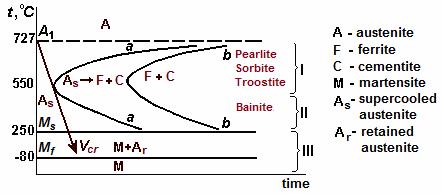
10.4. EQUILIBRIUM PHASE TRANSFORMATION IN STEELS
UPON COOLING
State diagrams are developed for equilibrium condition and very slow cooling. But in practice of heat treatment cooling rate may be significantly higher. The increase in the cooling rate leads to the growth in the degree of austenite supercooling t i. e. the transformation of austenite begins at lower temperature in comparison with the equilibrium one. Here the same law is observed as well as for crystallization.
Overcooling degree has effect not only on the transformation rate, but on the mechanism of overcooled austenite transformation as well, therefore, on structure and properties of its products.
As a rule, cooling is carried out continuously, but it is convenient to study kinetics of transformations (process development in time) in isothermal conditions (at constant temperature). Therefore for each steel the diagram of isothermal austenite transformation is plotted in co-ordinates “temperature
– time”. It is called also the C-shaped diagram (due to the form of curves). Plotting is conducted experimentally, considering the change of any properties, usually magnetic ones. The C-shaped diagram for eutectoid steel (0.8 % wt. C) is shown in Figure 10.5.
Two curves similar to the letter “C”, show the beginning (a curve a-a) and the completion (a curve b-b) of austenite transformation to other structures. To the left of the line a-a the field of overcooled austenite is located. As shown in the diagram, time of austenite existence at temperatures lower Ar1 is various and it depends on overcooling degree. The minimum stability of austenite is at 550 °С: time before the beginning of transformation makes only 1 second. At 700 °С this time is equal 10 s, and at 300 °С – already 60 s. To the right of the line b-b the field of equilibrium products of transformation is situated.
Figure 10.5 Diagram of isothermal austenite transformation for steel with 0.8 % wt. С
93
Created with novaPDF Printer (www.novaPDF.com). Please register to remove this message.
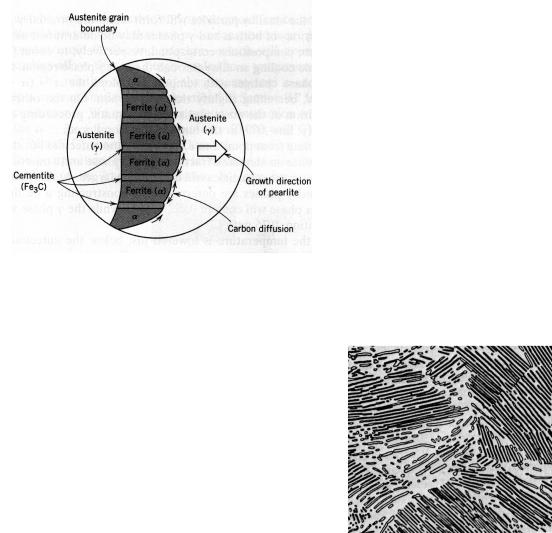
It means that, upon cooling, the solid γ phase, or austenite, is transformed to α iron, called ferrite, and cementite. The microstructure of the eutectoid steel slowly cooled through the temperature of phase transformation consists of alternating layers of the two phases. Both of them form simultaneously during the transformation. The composition of the parent phase is different from either of the product phases; therefore the phase transformation requires that there be a redistribution of the carbon by diffusion. Figure 10.6 illustrates schematically microstructural changes that accompany the eutectoid reaction (10.1). The directions of carbon diffusion are indicated by arrows.
The microstructure, shown in Figure 10.7, is called pearlite, because it has appearance of mother of pearl. The pearlite exists as grains, often termed “colonies”; within each colony the layers are oriented in the same direction, which varies from one colony to another. The thick light layers are the ferrite phase, and the cementite phase appears as thin lamellae most of which seem dark at this magnification. Mechanically, pearlite has properties intermediate between
the soft, ductile ferrite and the hard, brittle cementite. In the temperature range 727-
550 С (Fig. 10.5, field I) process of austenite transformation develops by diffusion way at the expense of redistribution of carbon atoms in a solid solution. Natural fluctuations of carbon content in each austenite grain occur all the time, but above temperature A1 they do not lead to phase transformations. Below critical point A1 austenite becomes thermodynamically unstable. Therefore, as soon as in austenite grain an area with the raised concentration of carbon arises, in this site at once
cementite crystal is formed. As a rule, it occurs on boundaries of grains
94
Created with novaPDF Printer (www.novaPDF.com). Please register to remove this message.

where origin and growth of a new phase is easier due to the raised deficiency of a lattice. Atoms of carbon join a growing cementite crystal from the adjoining areas, and in these sites with lower carbon content the polymorphic transformation Fe Fe occurs. Thus the nuclei of carbon-free phase – ferrite – appear.
The growing crystal of ferrite pushes away atoms of carbon which cannot occupy the places in its lattice, therefore an area enriched by carbon arises near the ferrite crystallite, where one more cementite crystallite is formed (Fig. 10.8, b).
Figure 10.8 Nucleation and growth of pearlitic colonies in austenite
Forming crystals of ferrite and cementite have lamellar shape and grow parallel to each other in both sides from grain boundary. Perlitic colonies originate simultaneously in other sections of austenite grain (Fig. 10.8, c). Diffusive transformation develops until the initial phase – austenite – fully disappear (Fig. 10.8, d). It is possible to represent this process as (10.1), or as following brief expressions:
|
Austenite0.8 Ferrite0.02 + Cementite6.7, |
(10.2) |
or |
Austenite0.8 Pearlite0.8. |
(10.3) |
The higher is the cooling rate, the higher is the degree of super-cooling of austenite and the more crystallites of new phase nucleate in a unit volume every second (as well as in crystallisation process). Therefore, the lower is the temperature of austenite/ferrite and cementite transformation the smaller are lamellae of these equilibrium phases. Their size is estimated by the average net width of the adjacent lamellae of ferrite and cementite which is called interlamellar distance (see Figure 10.9).
Products of pearlitic transformation are subdivided by the grain size (or by dispersion of structure) into coarse and fine pearlite. Mechanical properties depend on the grain size: both hardness and strength of steel
95
Created with novaPDF Printer (www.novaPDF.com). Please register to remove this message.
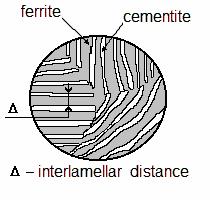
increase with the refinement of diffusion transformation products; on the contrary, both plasticity and toughness decrease (Table 10.1). The optimum combination of ductility and toughness corresponds to the interlamellar distance 0.3-0.4 µm.
As in each austenite grain a lot of pearlitic colonies arise, it is obvious that pearlitic transformation leads to steel grain refinement.
|
|
Figure 10.9 Definition of |
||
|
|
interlamellar distance |
||
|
Table 10.1 Products of diffusion transformation |
|||
Structure |
Temperature |
Interlamellar |
Hardness, HB |
|
of formation, С |
distance, µm |
|||
|
|
|||
Coarse |
670 |
0.5–0.7 |
170–230 |
|
pearlite |
||||
|
|
|
||
Pearlite |
590–640 |
0.3–0.4 |
230–330 |
|
(sorbite) |
||||
|
|
|
||
Fine pearlite |
550–580 |
0.1–0.2 |
330–400 |
|
(troostite) |
||||
|
|
|
||
10.5. NONEQUILIBRIUM PHASE TRANSFORMATION IN STEELS
Another type of phase transformation is developed when austenite is rapidly cooled to a low temperature.
The carbon diffusion in iron is slow down at low temperatures. At high cooling rate it is possible to cool austenite to the temperature at which diffusion practically does not take place. For eutectoid carbon steel it is approximately 250 С. Below 250 С, in the field III, the transformation of the supercooled austenite develops by the diffusionless mechanism (see Figure 10.5).
The horizontal lines restricting this field are marked out as Ms and Мf. Ms is the onset temperature, and Мf is the temperature of termination diffusionless transformation.
The diffusionless transformation occurs when the quenching rate is high enough to prevent carbon diffusion. In order to supercool austenite to the temperature Ms, it is necessary to reach the cooling rate exceeding magnitude Vcr. Critical cooling rate Vcr is a minimum value at which austenite does not transform by diffusion into ferrite and cementite mixture. Geometrically it is a tangent to the curve of the transformation beginning (line a-a).
96
Created with novaPDF Printer (www.novaPDF.com). Please register to remove this message.
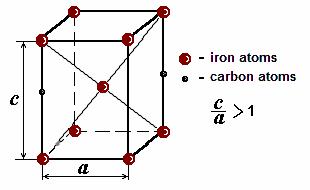
The austenite supercooled to point Ms undergoes polymorphic transformation Fe Fe which occurs without diffusion, i. e. is not accompanied by redistribution of carbon atoms. Transformation goes by the shear mechanism: at the expense of simultaneous displacement of all atoms in certain planes of a crystal lattice of iron to the distance less than interatomic one. Large number of atoms experience cooperative movements having only a slight displacement of each atom relative to its neighbors. It results in FCC austenite transformation to a body-centered tetragonal (BCT) crystal structure. In this case all the carbon atoms remain as interstitial impurities in iron. This supersaturated solid solution of carbon in a tetragonal lattice of iron is called martensite.
(The name is given in honour of A. Martens, German scientist.) The crystal lattice changes
and the neighboring atoms remain neighboring. All carbon dissolved in a lattice of iron, remains after transformation in the lattice ofiron.
As a result of diffusionless transformation FCC crystalline lattice of austenite is reconstructed to the BCC structure. But as in this lattice all the carbon atoms remain (in this case 0.8 % wt.) in
each unit cell of iron, this cell is deformed, extended and from cubic shape becomes tetragonal (Fig. 10.10). A measure of distortion of iron lattice is the relation of height of unit cell c to the basis side length a. The relation с/а increases with the increase of carbon content in solid solution.
The martensitic crystal has the shape of the plate similar to a convex lens. In cross-section of metallographic specimen it usually looks like a needle. The first martensite crystal arisen in austenite grain is limited by the sizes of this grain; crystals forming further do not cross each other and do not pass through the grain boundaries of austenite, therefore they have smaller sizes (Fig. 10.11). It is obvious that martensitic transformation, as well as pearlitic one, refine the grain of steel. Needle-shaped grains of martensite may be observed in Figure 10.13.
Of the various microstructures that may be produced for the given steels, martensite is the hardest and strongest and, in addition, the most brittle; it has, in fact, negligible ductility. Its hardness is dependent on the composition: the more carbon content, the harder martensite. For example,
97
Created with novaPDF Printer (www.novaPDF.com). Please register to remove this message.

for carbon content of 0.8 % wt. hardness of martensite makes 65 НRC (670 НВ); on the contrary, percent elongation and impact strength are close to zero. Martensite is a brittle structure; it cannot be plastically deformed or processed by cutting tool, except for abrasive one.
Figure 10.11 Scheme of martensite formation
High hardness of martensite is a result of stengthening caused by simultaneous action of all mechanisms of restricting the dislocations motion:
1)solid solution strengthening by dissolved atoms of carbon;
2)strain hardening caused by the growth of martensitic crystals;
3)strengthening by the grain size reduction;
4)strengthening by disperse particles of cementite Fe3C.
The main contribution to hardening is given by distortions of iron crystal lattice by the interstitual atoms of carbon. Therefore hardness of martensite depends on carbon content (Table 10.2).
Table 10.2 Hardness of martensite depending on carbon content
Content of carbon in |
0.2 |
0.3 |
0.4 |
0.5 |
0.6 |
0.8 |
1.0 |
|
martensite, % wt. |
||||||||
|
|
|
|
|
|
|
||
|
|
|
|
|
|
|
|
|
Hardness, НRC |
40 |
48 |
55 |
59 |
62 |
65 |
66 |
|
|
|
|
|
|
|
|
|
The martensite grains grow at a very high rate equal to the velocity of sound within the austenite matrix ( 5 km/s). Sometimes there is a sound effect produced. Prominent feature of martensitic transformations: it develops only at continuous cooling to a point Mf. At increase in the carbon content temperatures of points Ms and Мf go down, and martensitic transformation is displaced in the field of lower temperatures (Fig. 10.12).
It means that in actual practice of thermal processing all martensitic interval is not passed: usually cooling is carried out to the indoor temperature, i. e. approximately not lower than 20 С. Therefore martensitic transformation in steels containing more than 0.6 % wt. C does not reach the
98
Created with novaPDF Printer (www.novaPDF.com). Please register to remove this message.
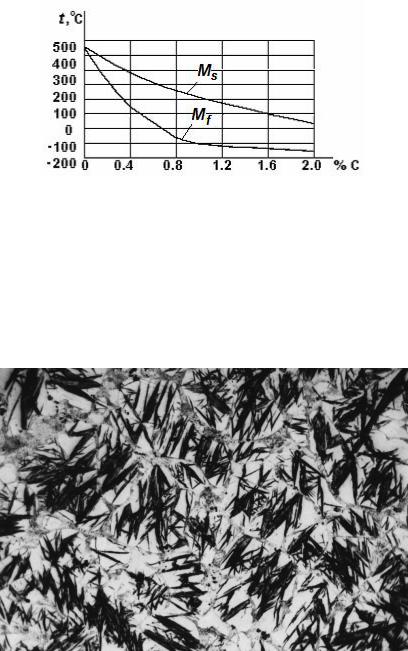
end, and after quenching the steel structure comprises some quantity of austenite. It is called retained austenite.
Figure 10.12 Dependence of temperatures of the beginning and the termination of martensitic transformation on the carbon content in steel
The quantity of retained austenite in the steel after quenching depends on the carbon content and temperature of the cooling medium. It can make some percent in high-carbon steels and tens percent in the alloyed steels.
To reduce the amount of retained austenite in high-carbon tool steels, they undergo cold treatment.
Figure 10.13 Photomicrograph of martensitic microstructure. The needle-shaped grains are the martensite phase, and the white regions are austenite that failed to transform during the rapid quenching. ?600
10.6. TRANSFORMATION UPON HEATING OF MARTENSITE
Martensite is a nonequilibrium single-phase structure; however, steels retain their martensitic structure at room temperature.
99
Created with novaPDF Printer (www.novaPDF.com). Please register to remove this message.

The atoms of carbon introduced in a crystal lattice of iron, create internal stresses. Each carbon atom is a point defect. Besides, in martensite the dislocation density (109-1012 cm-2) is great. Therefore martensite possesses the raised storage of internal energy. At a room temperature it can remain unrestrictedly long, but as soon as heating will give to atoms of carbon the additional energy necessary for diffusion, transformation of martensite to more equilibrium phases will begin.
At martensite heating carbon is precipitated out of solid solution, forming thus cementite Fe3C. Martensite dissolves onto ferrite and cementite mix. Depending on temperature and time of transformation there can appear spheroid structures – temper sorbite or troostite – instead of lamellar structures, received at transformation of overcooled austenite (Fig. 10.14).
Figure 10.14 Microstructure of lamellar and spheroid ferrite and cementite mixes having different grain size
So, under heating of martensite there are following processes:
1)decrease of carbon content in martensite and cementite formation;
2)reduction of internal stresses;
3)growth of cementite particles;
4)transformation of retained austenite to martensite (it is important for
steels with the carbon content 0.6 % wt. and especially for alloyed steels).
10.7. HEAT TREATMENT OPERATIONS
Annealing
The term annealing refers to a heat treatment in which a steel is exposed to an elevated temperature for an extend time period and then slowly cooled usually staying inside the furnace. Ordinarily, annealing is carried out to (1) relieve stresses; (2) increase softness, ductility and toughness; and/or
(3) produce a specific microstructure.
Figure 10.14 shows the portion of the iron–carbon phase diagram. The horizontal line at the eutectoid temperature, labeled A1, is termed the lower
100
Created with novaPDF Printer (www.novaPDF.com). Please register to remove this message.
